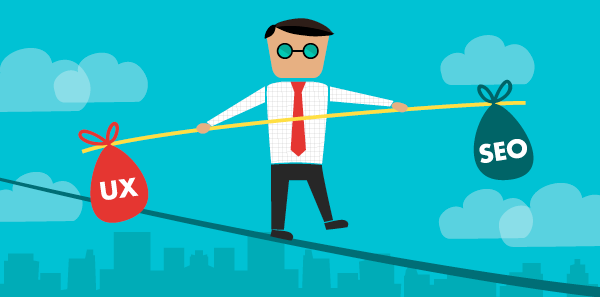4 Things that Happen when SEO and UX Share the Same Goals
If you work in SEO, one of the first questions you’ve been trained to ask a client is, “How do you measure success?” Defining the goals of a website can considerably shape the direction of a Web strategy, honing in on the actions and behaviors that matter. Without concrete goals, measuring performance can quickly become a pipedream, a line item in the backlog, or worse yet, a check mark next to “site is live.” When budgets are tight and data is plentiful, proving the success of a creative idea is as critical as the imagination behind it.
The second thing you learn as an SEO professional is that SEO success is largely out of your hands: your most critical metrics of success rely on other people’s work. When a website is built as one massive scrolling site, you can say goodbye to your organic rankings. When your site takes 20 seconds (AKA an eternity) to load on a phone, it’s so long to your mobile visitors, not to mention your good fortune in Google. SEO performance is contingent on site design and strategy, making buy-in from other team members is critical. Starting with user experience.
UX designers rely on wireframes, templates, interactions and storytelling to convey an experience, catered to the user. Meanwhile, SEO experts rely on search data directly from users to inform that same experience. SEO has the data that UX needs…UX has the tools and framework that SEO needs. The moment you recognize that SEO and UX are immeasurably (and measurably!) better working together than working in parallel is when usable design becomes usable and high-performing. The grand slam of home runs.
Here are 4 things that happen when SEO and UX are aligned to the same goals:
1. A usable and searchable site – a site is only useful if its users can find it. That 93% of online experiences start with a search* illustrates how a user’s experience starts even before arriving on the site.
2. UX decisions backed by real life user (search) data – UX designers often use prior experience from building other websites to validate design decisions. But often, business priorities and user needs differ from site to site. The great thing about SEO research is that you can mine for data and insights specific to an industry or client. By arming UX designers with real life user data – information directly from the people whom the web experience will serve – two things happen: first, design decisions are based on something even more tangible than prior experience. Second, SEO insights are baked into the site experience, effectively aligning SEO and UX to the same goals. Saying, “I know this is what my users care about,” always trumps, “I think this is what my users care about.”
3. Fewer post-launch errors leading to a smoother experience – SEO experts are really good at finding problems. Whether it’s an error page, a broken link or a redirect chain, we get a tiny surge of adrenaline when we discover these issues because they present an opportunity to improve the site. What’s important to recognize is that a broken link isn’t just an SEO problem; it’s a user problem. For example, users who click on a link expect to go somewhere new, to discover more information that they care about. They’re not eager to check out your error page, and they don’t have the patience to figure out where the real content is they were seeking. When solving site issues – both pre- and post-launch – is a priority for both SEO and UX, the user reaps the benefits.
4. Creative+ problem solving – being the person who “is good at identifying problems” may sound like a drag…and it often is. I’ve had numerous conversations with other SEO professionals who feel like they’re always in the position of being the naysayer, of reigning in ideas and explaining why something shouldn’t be done. Nobody actually enjoys being Negative Nancy (aside from maybe Nancy). But sometimes, identifying obstacles can lead to creative problem solving that makes the site even better than its initial design. I was recently working with a UX designer on developing a new site architecture. I explained to her how the proposed design limited our ability to optimize for some long tail but highly relevant topics. In the end, we were able to modify the site architecture and templates to accommodate this additional level of content, a concept that was then reused throughout the site. Our partnership facilitated an SEO goal, but also improved upon the design. Creative+ problem solving at its finest.
A fifth bonus point: when SEO and UX are held to the same goals, you find more people to champion your cause. For SEO experts, the UX champions are the ones who stop to consider how something might work from an SEO perspective, or to wonder what search data might help them make a more informed design decision. When SEO and UX share in their knowledge and goals, the result is a usable site that also performs. And I guarantee that you’ll never hear a complaint about that.
*This statistic is from a 2011 Search Engine Journal article; if you know of a more updated stat, I’d love to hear from you!
